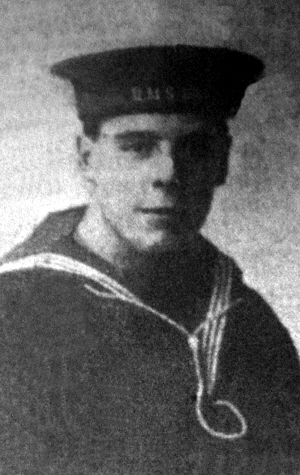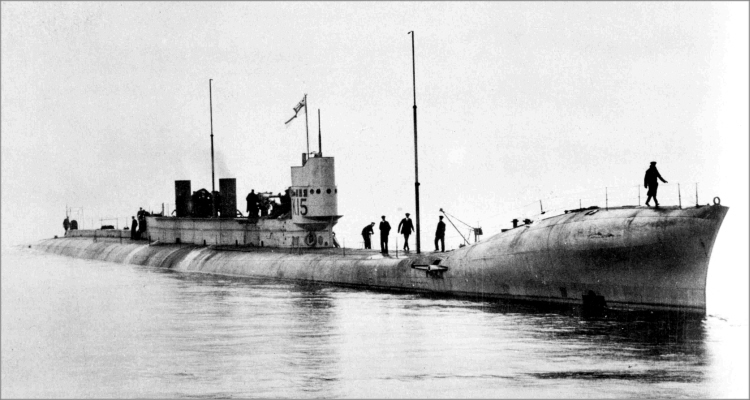 Able Seaman Harold Nettleton, J/20766, Royal Navy, H.M.S. Submarine 'K.17'
Able Seaman Harold Nettleton, J/20766, Royal Navy, H.M.S. Submarine 'K.17'
Harold Nettleton was born in Ossett on the 6th July 1895, the son of John William Nettleton and his wife, Ada (nee Green), who married at Ossett Holy Trinity Church on the 2nd June 1892. The couple had three children from their marriage and all of the family were born in Ossett.
In 1901, John William Nettleton, a joiner, wife Ada and two of their children, George and Harold, were living on Dewsbury Road, Ossett. John William died in June 1910, at the early age of 40 years and by 1911 Harold, aged 19, was living with his widowed mother and his four year-old, sister Alice Mabel, at 61, Springstone Avenue, Ossett. Harold was working for Riley’s as a firework maker.
Harold Nettleton’s first Royal Navy posting was to the HMS 'Vivid', Royal Navy Training Barracks at Devonport which he joined as a 'Boy 2' rating on the 14th October 1912. He was then 17 years old and he progressed to rating 'Boy 1' on the 13th December 1912 and remained so until the 30th May 1913 when he moved to HMS 'London'.
He served aboard, first as a 'Boy 1' rating and from his 18th birthday, on the 6th July 1913, as an Ordinary Seaman. This was the day Harold signed up with the Royal Navy for 12 years. He was 5’ 3½” tall, but by the age of 18 he had grown another inch. He had brown hair, brown eyes and a fresh complexion with a tattoo of a bunch of flowers with ribbon, Ada, on his right arm.
He stayed with HMS 'London' until the 1st October 1913 when he was ashore at HMS 'Pembroke Barracks', Chatham, where he spent six weeks. He transferred to HMS 'Diamond' where he was made able seaman, but returned five months later to Pembroke Barracks on the 25th April 1914. After a month there he was on the move again to HMS 'Actaeon' where he was serving when war was declared. He remained with this ship until the 14th October 1914 when he once again returned to HMS 'Pembroke Barracks' at Chatham where remained until the 31st January 1915. Harold then spent a year aboard HMS 'Sirius' followed by seven months with HMS 'Dolphin' where he served until the 15th September 1917, when he was transferred to the K-Class submarine.
In common with most ratings his conduct and ability was assessed in each December of his service when his conduct was marked 'very good' and his ability 'satisfactory'.
Able Seaman Harold Nettleton was posthumously awarded the British and Victory medals and also the 1914/15 Star, which was awarded in recognition of his service overseas before the 31st December 1915. Harold’s next-of-kin was named as his brother, George Nettleton of Shepherd Hill Farm, Ossett who himself was to die from influenza in late 1918.
Harold Nettleton was drowned when the K-Class submarine K17 that he served on was sunk on the 31st January 1918 during the night time fleet exercises later known as the 'Battle of May Island' (Operation E.C.1) when she was attached to the 13th Submarine Flotilla. Driven by oil-fired steam turbine engines, the K-Class submarines were large and cumbersome, too slow to keep up with surface ships, hard to manoeuvre and stifling for their crews. The K-Class submarines were notorious and hated by the men who sailed them. Hence the crew were called 'Suicide Club'.
Whilst taking part in exercises off May Island, K17 was astern of the cruiser HMS 'Courageous', when the latter changed course to avoid two trawlers which were spotted ahead. Submarine K17 turned, but two other submarines K22 and K14 were involved in a collision. Meanwhile scout cruiser HMS 'Fearless' was steaming at 21 knots towards the area oblivious of the accident. Suddenly the 'Fearless' appeared over the horizon and ploughed into the submarine K17, and water gushed into the boat through the pierced pressure hull. The order to abandon ship was quickly given. Within eight minutes the K17 had disappeared, but 18 men managed to escape through the hatch and the other submarines attempted to pick them up. Sadly the destroyers escorting the main body of ships were unaware of the location of the accident and ploughed through the survivors. Only nine men from the submarine K17 survived. Able Seaman Harold Nettleton's body was never recovered.
The wreck of the K17 is designated as a protected place under the Protection of Military Remains Act 1986. However, an offshore wind farm, known as 'Neart na Gaoithe', is to be constructed in the area of the 1918 Battle of May Island when 270 men died after a series of collisions. As a result, the wrecks of the two sunken submarines, 100 metres apart and 50 metres down have been surveyed by divers from specialist marine consultants.1
In the same sorry incident, another K-Class submarine, the K4, was also lost after being accidently rammed by the submarine K6, which was taking avoiding action to avoid being rammed by the battlecruiser 'Australia'. The submarine K7 also ran over the sinking hull of the K4. The entire 59-man crew of K4 was lost. In addition the submarine K22 was rammed by K14, and as they lay locked together, they were run down by the Battlecruiser 'Inflexible', which struck the K22 and bent her already damaged bows at right angles to the hull. Fortunately both K14 and K22 survived.
So embarrassing was the incident that even though one officer was court-martialed, the facts were not generally admitted for more than 60 years, until after the death of the last survivor. The Royal Navy hushed up the catastrophe and it was not until 2002 that a commemorative plaque was erected on a cairn in Anstruther, the nearest village on the coast, though even that does not refer to the cause of the loss of life. The Submariners' Association does, however, now hold an annual commemorative service.
The "Ossett Observer" 2 had this obituary for Harold Nettleton:
"An Ossett Sailor Drowned - The news was received from an official source on Monday that Able Seaman Harold Nettleton (22), whose mother used to keep the farm at Shepherd-hill, Flushdyke, lost his life by drowning at sea on the previous Thursday. The deceased was making capital progress in the Navy, in which service he enlisted five years ago last October. Before going to sea he was employed in the corporation's waterworks department, and was well-known in the borough. He was a scholar of the Central Baptist Sunday School, Church-street, and as recently as last Sunday a letter was read from him at the school, which he had forwarded in acknowledgement of a New Year's gift sent to him from the school."

Above: K-Class submarine K15, sister ship to ill-fated K17 in which Harold Nettleton lost his life.
Able Seaman Harold Nettleton, aged 22 years, son of Ada Gilbertson (formerly Nettleton), of 20, Woodbine Street, Ossett, and the late John William Nettleton, died on the 31st January 1918. He is remembered at panel reference 28 the Chatham Naval Memorial, 3 Chatham, Kent. The Memorial overlooks the town of Chatham and is approached by a steep path from the Town Hall Gardens.
After the First World War, an appropriate way had to be found of commemorating those members of the Royal Navy who had no known grave, the majority of deaths having occurred at sea where no permanent memorial could be provided.
An Admiralty committee recommended that the three manning ports in Great Britain - Chatham, Plymouth and Portsmouth - should each have an identical memorial of unmistakable naval form, an obelisk, which would serve as a leading mark for shipping. The memorials were designed by Sir Robert Lorimer, who had already carried out a considerable amount of work for the Commission, with sculpture by Henry Poole. The Chatham Naval Memorial was unveiled by the Prince of Wales (the future King Edward VIII) on 26 April 1924.
After the Second World War it was decided that the naval memorials should be extended to provide space for commemorating the naval dead without graves of that war, but since the three sites were dissimilar, a different architectural treatment was required for each. The architect for the Second World War extension at Chatham was Sir Edward Maufe (who also designed the Air Forces memorial at Runnymede) and the additional sculpture was by Charles Wheeler and William McMillan. The Extension was unveiled by the Duke of Edinburgh on 15 October 1952.
Chatham Naval Memorial commemorates 8,517 sailors of the First World War and 10,098 of the Second World War.
References:
1. Divers survey Scottish graveyard of WW1 submarine disaster - "The Guardian", 29th August 2011
2. "Ossett Observer", 9th February 1918